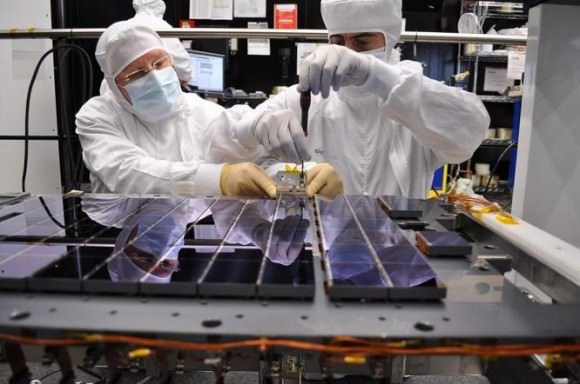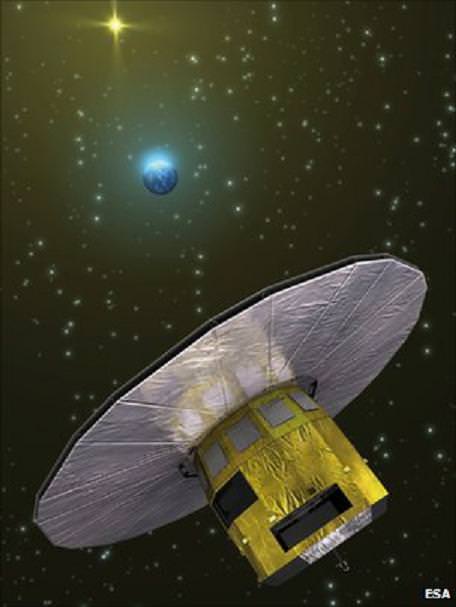[/caption]
Its name is GAIA and it’s perhaps the most ambitious project which has ever faced the European Space Agency. Scheduled to launch in 2013, this new breed of space telescope will stately progress to Lagrange Point 2, where it will spend the next five years. Its mission? To create the largest and most precise three dimensional chart of our Galaxy by providing unprecedented positional and radial velocity measurements for about one billion stars in our Galaxy and throughout the Local Group.
While this number represents perhaps only 1% of the Milky Way’s stellar population, the GAIA mission will be “seeing” far more than just stars. Its astrophysical information data base will work hand-in-hand with on-board multi-color photometry… providing an information set which has the precision necessary to quantify the early formation, and subsequent dynamical, chemical and star formation evolution of the Milky Way Galaxy. As a result of its tracking capabilities, GAIA will also capture information on asteroids, comets, extra-solar planets and even low temperature, low mass objects. Its sensitive equipment will sweep over neighboring galaxies and reach out into space for a half million quasars. GAIA will push the boundaries of general relativity and cosmology to the limits.
What’s inside? GAIA will carry twin telescopes complete with two camera arrays incorporating charge coupled devices – each one measuring 45.0mm by 59.0mm and encompassing 1,966 pixels by 4,500 pixels. “The mounting and precise alignment of the 106 CCDs is a key step in the assembly of the flight model focal plane assembly,” said Philippe Gare, ESA’s GAIA Payload Manager.
The diminutive sensors will be placed in rows across a silicon carbide framework and span an area just slightly under half a square meter. It’s a billion little eyes ready to be turned towards the skies…
However, no optical telescope is complete without a mirror assembly and GAIA delivers. It is crafted with a set of 10 mirrors… all with outstanding physical and optical characteristics. “Since the design process began in 2006, the GAIA team has learned how to produce a set of sintered silicon carbide mirrors which is not only extremely strong and ultra-stable – with about twice the rigidity of steel – but also lightweight and with a high thermal conductivity,” said Matthias Erdmann, ESA’s GAIA Payload Systems Engineer responsible for optics and ceramics.
“Although these are not the first silicon carbide mirrors that have been made for a space mission, no mirrors as large as the GAIA primary mirror have previously been coated using the CVD process,” he added. “The degree of similarity of the mirror pairs is also quite unique. This is particularly important for GAIA , since each telescope must have similar optical capabilities, with diffraction limited viewing and minimal wavefront errors. Their outstanding optical characteristics achieve new standards that will be of great value to the development of future space observatories. As a result of this programme, the European industrial team has been able to master all of the processes required for making state-of-the-art space mirrors, and become the world leader in silicon carbide mirror technology.”

But getting GAIA into space hasn’t been an overnight process. From initial approval of the project to launch encompasses 13 years – and an additional 7 to 8 to analyze the resulting data. Just consider its downlink – about 5 Mbit/s during its daily passes. While that’s comparable to a home broadband system, GAIA isn’t doing it from home. It’s transmitting from a million and a half kilometers away.
“The raw data that has to be collected is about 100 terabytes, and when all the data are processed in the archive we are talking about up to one petabyte,” says Giuseppe Sarri, Esa’s Gaia project manager. “For the analysis, a supercomputer will be needed to get out all the numbers.”
Yet, Gaia is not the first space mission to chart the heavens. In 1989, ESA also took on Hipparcos – a catalog effort well known even to the amateur community. It produced a primary catalogue of about 118 000 stars, and a secondary catalogue, called Tycho, of over 2 million stars. Even these impressive numbers will pale next to GAIA, whose mirrors will collect thirty times more light and measure a star’s position and motion two hundred times more accurately. At the end of its five-year mission, the information will fill over 30,000 CD ROMs – filled with 1000 million celestial objects – and be freely distributed to the astronomical community.
And we’ll be waiting…
For Further Reading: GAIA Mission Pages.


Yo Tammy, at the beginning of the first line, it should be Its, not “It’s”.
Also in the first line, there’s a superfluous definite article “the” between “it’s” and “perhaps”.
In the fourth line, “It’s mission?” should be: Its mission?
At the fifth paragraph, in the second line, two L’s are sufficient in the term all.
(Now I’ll have to read the article again because I’ve forgotten what the subject is about!)
all this would be OK if i knew what superfluous meant… 😉 wow… only three major mistakes and all that while i was sippin’ coffee and hoping the skies would clear for the orionid meteor shower. i was so excited i couldn’t sleep last night, because there was a remote chance it would clear. notice i used the word “remote” superfluously… (she giggles and ducks!)
HeyUP! Coffee jitters? I went ‘up the mountain’ last night with my little 4″ and set up by the side of the road. My ‘spot’ is getting smaller due to nearby road construction = dzzzzz. Found Comet Garradd, then checked out my new favorite “The Cygnus Loop”. Stopped in to view M31 & M33 (Total of 4 galaxies) then M13, M57, the Double Cluster in Perseus and M1. In between finding ‘old friends’ I’d sit back in my camp chair and look for Geminids. I only saw a total of 6 from 8pm – 12am, with one spectacular fireball!
Shoulda woulda stayed up later? But was beat, getting up at 5am that morning.. so was wary seepy and still had to drive down the twisty winding mountain road to get Ommm. Regardless… it was ‘trick’! I just love my stars!
nice report Tammy!!
Too much data? Is that possible? This mission looks pretty ‘far out’, literally and figuratively. Thanks for the report Tammy… I’d forgotten about this one..
This instrument should be senisitive enough to detect smaller exoplanets than ground based telescopes as well as studying stars much further out than currently possible. This will be a very interesting mission with lots of discoveries to be teased out of the massive flood of data to follow.